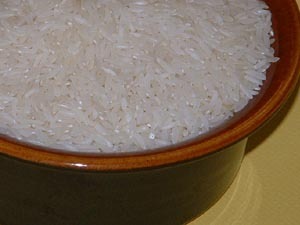What is white rice, and does it grow that way?
The inside of a rice kernel is white. Its covering (husk, bran and germ) is brown. Thus, all rice as we know it, starts out brown, according to the Cambridge World History of Food, published by the Cambridge University Press.
White rice has been stripped of nutrients and fiber (husk, bran and germ), according to Wikipedia. Like any low-fiber or fiber-free starch, when eaten, white rice causes the pancreas to secrete large amounts of insulin, according to the American Diabetes Association, Inc. (Diabetes Care 27:538-546, 2004). The risk of diabetes increases with the habitual consumption of moderate-to-large amounts of these low-fiber or non-fiber starches, and thus do not promote good health. A person who is diabetic must avoid white rice and other low-fiber starches.
Thus, to answer the question: “Can white rice contribute to diabetes?” the answer is yes, according to the American Diabetic Association who teaches that brown rice should be consumed in place of white rice.
What is brown rice, and does it grow that way?
Brown rice is in its natural state with no nutrients or fiber removed. Brown rice is more nutritious and contains valuable dietary fiber, which prevents it from being the diabetes promoter that white rice is sometimes labeled, according to wikipedia. The natural bran and germ in brown rice are what categorizes it as a healthy food that is safe for a diabetic to consume (in small-to-moderate quantities), according to the American Diabetic Association.
How much healthier is brown rice than white rice?
The below nutrition details on rice were obtained from Spark Recipes at http://recipes.sparkpeople.com/recipe-calculator.asp. A comparison between the nutritional values of the white rice versus the brown rice show the brown rice to be superior.
Nutrition in ¼ cup uncooked white rice:
Calories 60.5
Fat 0.1 g
Cholesterol 0.0 mg
Potassium 12.1 mg
Carbohydrate 13.4 g
Protein 1.1 g
The below percent Daily Values are based on a 2,000 calorie diet. Your daily values may be higher or lower depending on your
calorie needs.
Folate 6.9%
Iron 3.8%
Manganese 8.3%
Niacin 3.5%
Selenium 5.0%
Thiamin 5.1%
Less than 2% (negligible amounts) of the following: Vitamin B-6, copper, magnesium, pantothenic acid, phosphorus, riboflavin, zinc
Nutrition in ¼ cup uncooked brown rice:
Calories 54.6
Fat 0.4 g
Cholesterol 0.0 mg
Sodium 0.5 mg
Potassium 38.5 mg
Total Carbohydrate 11.5 g
Dietary Fiber 0.9 g
Protein 1.1 g
The below percent Daily Values are based on a 2,000 calorie diet. Your daily values may be higher or lower depending on your calorie needs.
Vitamin B-6 3.6%
Copper 2.0%
Magnesium 5.4%
Manganese 26.7%
Niacin 3.2%
Phosphorus 3.8%
Thiamin 3.3%
Zinc 2.0%
Less than 2% (negligible amounts) of the following: Calcium, folate, iron, pantothenic acid, riboflavin
Recipe for cooking rice
White rice. Mix together 1 cup rice, 2 cups water, and 1 teaspoon salt. Bring to boil, simmer (covered) 20 minutes.
Brown rice. Mix together 1 cup rice, 2 1/2 cups water, and 1 teaspoon salt. Bring to boil, simmer (covered) 45 minutes.
After the cooking time is completed, check the rice with a spoon to see if there is any water at the bottom of the pan. If there is, cook the rice (covered) an additional 5 to 10 minutes until the water is completely absorbed.
Two thing to watch for when cooking rice (especially white) are:
1. Watch carefully that it does not boil over, and
2. Watch that it does not scorch during the simmering.
History of rice
Wikipedia states that rice has been eaten in Asia since hominids arrived (http://en.wikipedia.org/wiki/Rice#Asia). Evidence of hominids in Asia dates back 500,000 years, according to “Australasian Ufologist Magazine” Vol 3, No. 3, 3rd Qtr 1999. That means rice has been eaten for a very, very long time (brown rice). It wasn’t until 1860 that white rice was “discovered” and mass produced by processing equipment that was invented in Scotland.
Unfortunately, people had no idea how lacking in nutrition the fluffy white rice was that they were eating in the 1800s. When nutrition declines, so does the immune system, according to WellBeyond100.com.
Thankfully, today we have access to a wealth of knowledge about nutrition and which foods we should be eating in order to stay healthy. We live in a time where many of us are able to avoid chronic illnesses such as diabetes, heart disease, and strokes by following healthy guidelines for a healthy lifestyle.
References:
Cambridge World History of Food, published by the Cambridge University Press
Australasian Ufologist Magazine Vol 3, No. 3, 3rd Qtr 1999
http://www.WellBeyond100.com/WhatIsAging.aspx
American Diabetes Association, Inc. (Diabetes Care 27:538-546, 2004)





